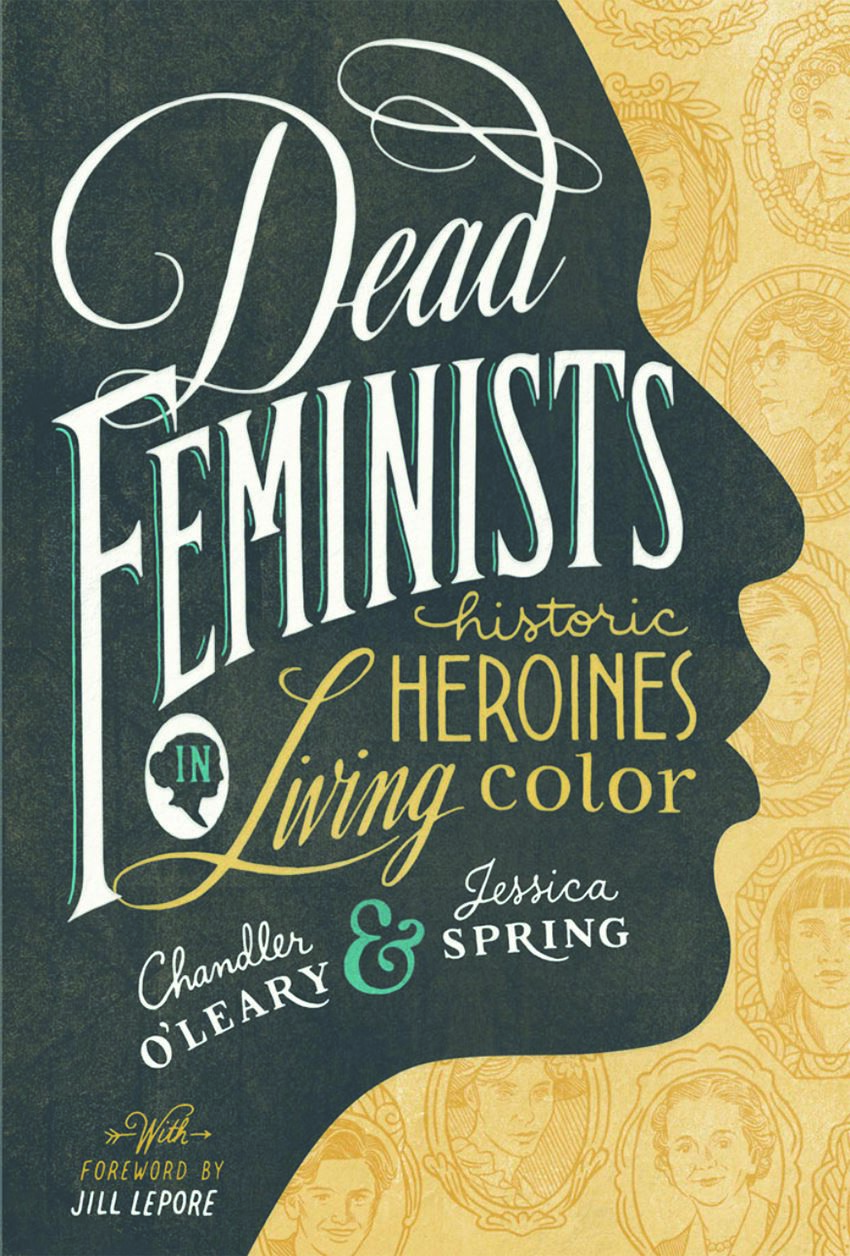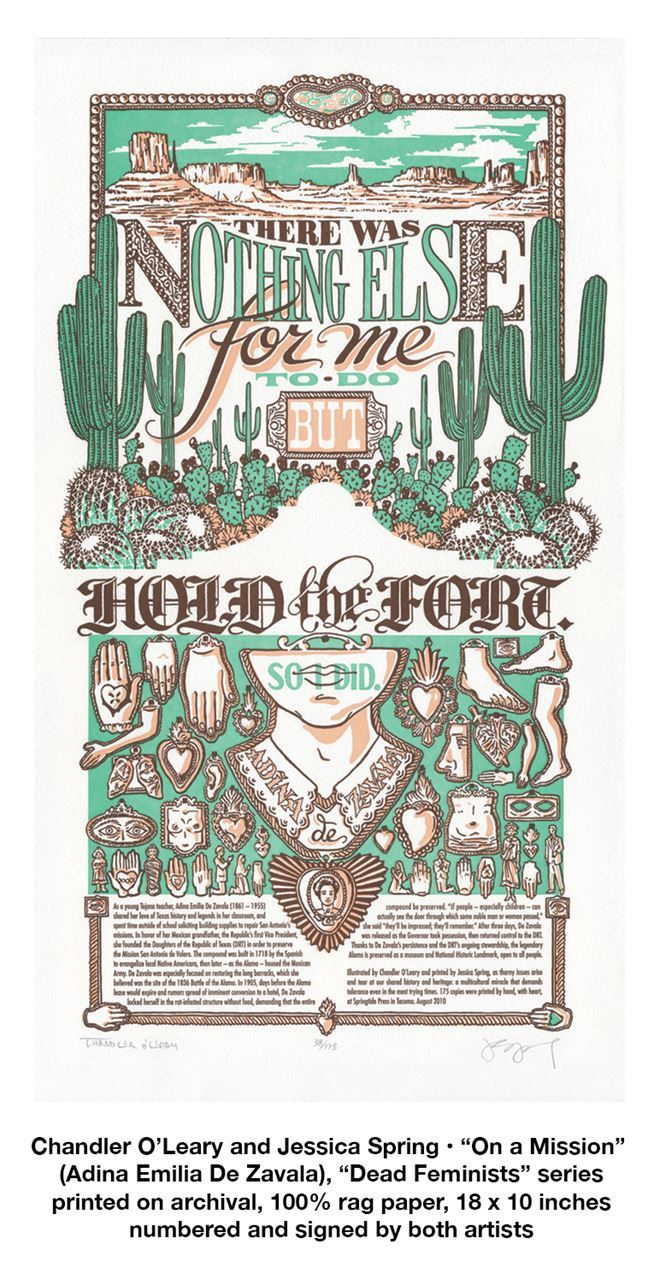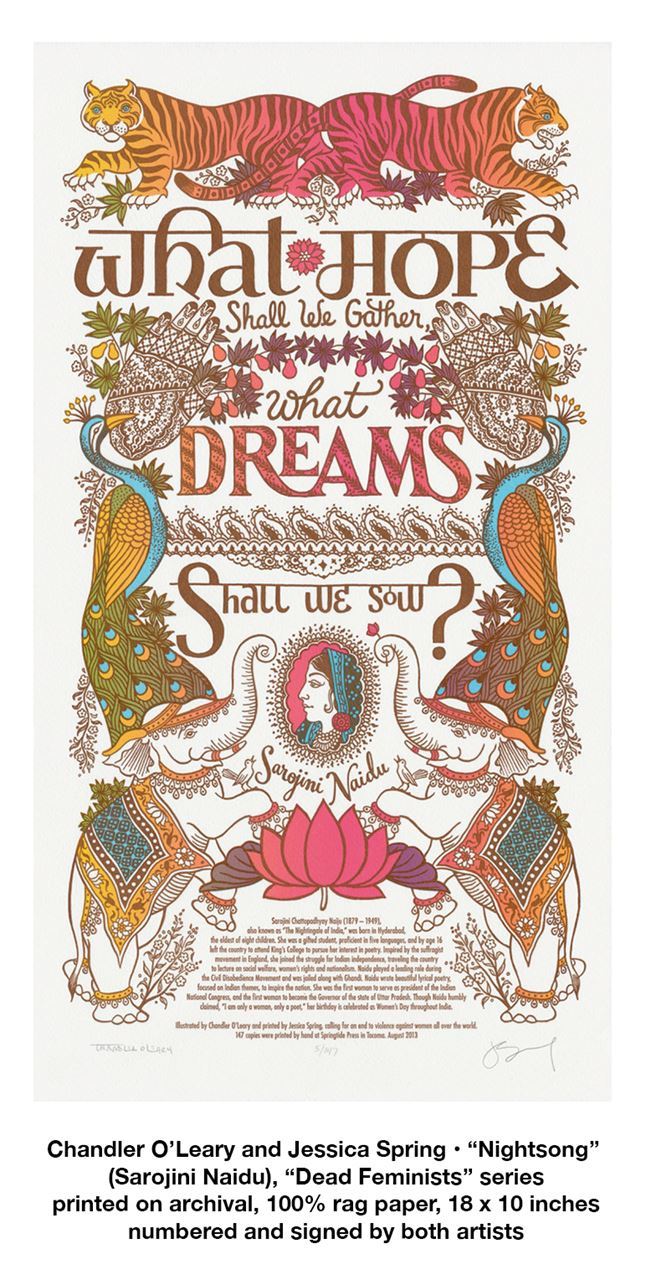
Dead Feminists: Historic Heroines in Living Color
by Jessica Spring & Chandler O’Leary (Sasquatch Books)
 Feminism has necessarily evolved to acknowledge oppressions of race, class, gender, sex, and other identities as inextricably interrelated issues. Intersections are richly entwined and depicted throughout Dead Feminists: Historic Heroines in Living Color (Sasquatch Books, 2016). As a compilation of broadside prints celebrating an expansive variety of women speaking in defense of their beliefs, it won the 2018 Pacific Northwest Book Award. It is also more than the sum of its parts: a testament to the power of art and artists to instigate change; documentation of the relationship between co-creators Chandler O’Leary and Jessica Spring; and, in the wake of O’Leary’s sudden death last year, a legacy.
Feminism has necessarily evolved to acknowledge oppressions of race, class, gender, sex, and other identities as inextricably interrelated issues. Intersections are richly entwined and depicted throughout Dead Feminists: Historic Heroines in Living Color (Sasquatch Books, 2016). As a compilation of broadside prints celebrating an expansive variety of women speaking in defense of their beliefs, it won the 2018 Pacific Northwest Book Award. It is also more than the sum of its parts: a testament to the power of art and artists to instigate change; documentation of the relationship between co-creators Chandler O’Leary and Jessica Spring; and, in the wake of O’Leary’s sudden death last year, a legacy.
Dead Feminists began as an intersection of two people with a shared art form. In 2008, illustrator, lettering artist and entrepreneur Chandler O’Leary arrived in Tacoma and shortly after, met designer, letterpress printer and book artist Jessica Spring at the Seattle Wayzgoose printing celebration. They connected over their love of type and discovered they lived just blocks apart. Their conversation continued, honed during what was a volatile election year infused with derisive commentary about the women candidates’ appearance or readiness for the job. One day, Spring came to O’Leary with an Elizabeth Cady Stanton quote: “Come, come my conservative friend, wipe the dew off your spectacles and see the world is moving.” Spring hoped O’Leary could merely illustrate Sarah Palin’s eyeglasses to accompany the text. O’Leary went much further, combining ornate hand lettering for the quote, intertwined with the infamous spectacles. These words, still relevant in the midst of cultural conflict, prompted the two to create their first print together.
That they expressed their work in the form of a broadside, a poster format used historically to spread the word about political ideas, was intentional. O’Leary and Spring both had backgrounds in design and typography, and experience in the male-dominated lineage of printmaking. While they didn’t know then that this would result in a series, they did create an edition. The 44 prints that were run of the Stanton piece represented a significant number, in honor of the 44th presidential election. Symbolism and layers of meaning continued to be important pieces of each subsequent broadside, a considered fusion of text, image, and content that amplified quotes by women aligned with contemporary social justice issues. While Dead Feminists compiles a collection of 24 of these prints, the series continued for a total of 33 broadsides.
 As artists accustomed to being solo in their respective studios, working in tandem generated layers of meaning and labor that shaped their collaboration. It is striking to consider that while each brought individual strengths, they were both involved with every creative step of their process together. Each broadside was generated using a mix of traditional and contemporary letterpress processes that combined hand and digital applications. Chandler’s renderings were transformed into photopolymer plates that were run manually by Spring through her Vandercook press. A single color was printed at a time, so a multicolor print had to be run through the press multiple times. Each run required precise registration for accurate alignment so that transparent inks either lay beside or layered on top of each other to create the resulting multicolored image. Constant testing and adjustment happened along the way.
As artists accustomed to being solo in their respective studios, working in tandem generated layers of meaning and labor that shaped their collaboration. It is striking to consider that while each brought individual strengths, they were both involved with every creative step of their process together. Each broadside was generated using a mix of traditional and contemporary letterpress processes that combined hand and digital applications. Chandler’s renderings were transformed into photopolymer plates that were run manually by Spring through her Vandercook press. A single color was printed at a time, so a multicolor print had to be run through the press multiple times. Each run required precise registration for accurate alignment so that transparent inks either lay beside or layered on top of each other to create the resulting multicolored image. Constant testing and adjustment happened along the way.
The fluid collaborative energy O’Leary and Spring generated while making the broadsides is evident in the book. Each broadside is augmented with explanatory text evoking issues of the time during which each quoted feminist was living. In O’Leary’s words, “We wanted it to be about all of humanity, through the lens of women’s contribution to humanity.” The array of women portrayed reveals the collaborators’ care and inclusion of diverse races, cultures, and points of view. Chapter headings are verbs that suggest actions to continue to move humanity in a more equitable direction, admonishing us to build, grow, protect, make, tell, lead, play, and share.
 The artists lived into the ideas that they set forth in their book, putting words into action. Starting in 2010, the artists began giving donations to organizations that aligned with the causes embodied by the broadsides. They later started the Dead Feminists Fund, carrying forward a mission of supporting fledgling nonprofits that empower women and girls to become community forces for good. It is fitting that layers continue to be a central reason why Dead Feminists: Historic Heroines in Living Color remains relevant eight years after its initial publication. It is the combined impact of the layers of ink, the art, the way these two women connected and collaborated, and the importance of the stories they depict that keep reaching for us.
The artists lived into the ideas that they set forth in their book, putting words into action. Starting in 2010, the artists began giving donations to organizations that aligned with the causes embodied by the broadsides. They later started the Dead Feminists Fund, carrying forward a mission of supporting fledgling nonprofits that empower women and girls to become community forces for good. It is fitting that layers continue to be a central reason why Dead Feminists: Historic Heroines in Living Color remains relevant eight years after its initial publication. It is the combined impact of the layers of ink, the art, the way these two women connected and collaborated, and the importance of the stories they depict that keep reaching for us.
Kristin L. Tollefson
Kristin L. Tollefson is an artist and educator based in Tacoma, Washington.
For further information about the Dead Feminists book and series, visit www.deadfeminists.com and www.springtidepress.com.